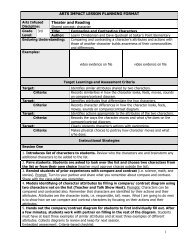Autonomy Rubric for Teachers (A.R.T.) - Arts Impact
Autonomy Rubric for Teachers (A.R.T.) - Arts Impact
Autonomy Rubric for Teachers (A.R.T.) - Arts Impact
Create successful ePaper yourself
Turn your PDF publications into a flip-book with our unique Google optimized e-Paper software.
<strong>Autonomy</strong> <strong>Rubric</strong> <strong>for</strong> <strong>Teachers</strong>Since 2002, <strong>Arts</strong> <strong>Impact</strong> has used an analytic rubric to measure the levels of teacher per<strong>for</strong>mance inplanning, teaching, and assessing in its programs. This evaluation protocol, known as the <strong>Autonomy</strong><strong>Rubric</strong> <strong>for</strong> <strong>Teachers</strong> (A.R.T.), is designed as a tool <strong>for</strong> facilitating continuous growth in teacher practice.In Year One of training the Artist-Mentor uses the tool as a way to track and give objective feedback toclassroom teachers about their mentorships.In Year Two of training both the teacher and their Artist-Mentor use the A.R.T. independently to reflect onthe mentorship. They then take the opportunity to share their reflections on their individual scoring andconsider the overall growth by the teacher in teaching the arts. The tool is used by classroom teachers <strong>for</strong>goal setting and continued planning <strong>for</strong> further professional development in arts and arts-infused teaching.The tool is attached to this document. In some <strong>Arts</strong> <strong>Impact</strong> programs, only the teaching and assessmentsections will be used. The version of the document you receive will reflect the appropriate sections <strong>for</strong> yourwork.Circle the level of per<strong>for</strong>mance you feel most closely reflects your work. Many teaching dynamicsare a lifelong learning curve, but by making an appraisal of where you stand thus far, you and yourinstructors have a better understanding of where <strong>Arts</strong> <strong>Impact</strong> can best place its training ef<strong>for</strong>ts.After you complete planning your lesson, as soon as possible (if applicable): Independently circle one rubric level (1-4) <strong>for</strong> each of the seven planning strands;All <strong>Arts</strong> <strong>Impact</strong> programs:After you complete teaching your lesson, as soon as possible: Independently circle one rubric level (1-4) <strong>for</strong> each of the six teaching strands;After your complete independently assessing the student artwork or per<strong>for</strong>mances, and be<strong>for</strong>e youdiscuss assessments with your Artist-Mentor: Independently circle one rubric level (1-4) <strong>for</strong> each of the three assessment strands. In the assessment meeting, talk about the levels of autonomy you have achieved as you reflecttogether—discuss the areas where your scoring is different than the Artist-Mentor’s scoring. Take time tocelebrate your strengths, and talk about strategies you could pursue to realize continuous growth in artsteaching.Our THANKS <strong>for</strong> using this tool! And congratulations <strong>for</strong> your reflective teaching practice!<strong>Arts</strong> <strong>Impact</strong> <strong>Autonomy</strong> <strong>Rubric</strong> <strong>for</strong> <strong>Teachers</strong> 2010-2011 – 11.15.2010 1
INDICATORS OF TEACHER’S AUTONOMY FOR ARTS INSTRUCTIONTeacher Name School DateRater: Self Artist-Mentor Evaluator/StaffDirections: Circle the description <strong>for</strong> each strand that best illustrates LESSON PLANNING. (A-M=artist-mentor)PLANNING Teacher of arts…. 4 3 2 11. States the big idea that goes beyond aspecific lesson (enduring understanding)Observations:Identifies a big ideathat transfers acrossexamplesIdentifies anidea related toa specificcontextIdentifies athemeMakes unsuccessfulef<strong>for</strong>t to identify anoverarching big ideaNOTE: Definition of big idea: A relationshipbetween two concepts, e.g. “A character’sobjective can define the sequence of thestory.”2. Writes learning targets (knowledge—concepts and skills—techniques)Observations:Identifies specific,knowledge and/orskills related to Statestandards (EALRs)and framework levelsIdentifiesknowledgeand/or skillsbut withoutknowing itrelates to StateframeworksIdentifiesnonspecificknowledgeand/or skillsMakes unsuccessfulef<strong>for</strong>t to identifyknowledge and/orskills; doesn’t knowwhat students shouldknowNOTE: Teacher should relate the knowledgethat is being taught to State frameworks.3. Writes traits (attributes) of criteriaObservations:Writes attributes thatcan be observed andscored objectivelyWrites attributesthat can beobserved, butmight bescoreddifferently bytwo ratersWrites vagueattributes thatcan’t beobserved orscored validlyMakes unsuccessfulef<strong>for</strong>t to identify anyattributes4. Instructional Plans include:a. Writes teaching strategies insequenceObservations:Sequences allsteps inincremental order(Includingtransitions)Sequences majorstepsLists some stepsbut omits majorstep(s)Makes unsuccessfulef<strong>for</strong>t to identify thesequence ofactivities; stalled atevery stepb. Writes learning promptsObservations:Writes prompts andquestions toinvolve studentsin conceptunderstanding(includes conceptin prompts)Writes questionsto involvestudentparticipation(uses inquiry)Writes promptswith no studentinteraction(direct teaching)Makes unsuccessfulef<strong>for</strong>t to write anyprompts orquestions<strong>Arts</strong> <strong>Impact</strong> <strong>Autonomy</strong> <strong>Rubric</strong> <strong>for</strong> <strong>Teachers</strong> 2010-2011 – 11.15.2010 2
c. Identifies supporting culturalresourceNOTE: This strand focuses on planning <strong>for</strong>the cultural study trip.d. AssessmentsObservations:Researches orseeks help inidentifying a relatedresource,referencesresource in lesson,AND study trip(writes a promptassociated with thestudy visit; knowsto call the culturaleducator)Selects andembeds multiplecriteria-basedassessmentstrategies(whenever requiredby a teachingstrategy)Researches orseeks help inidentifying arelated resource,referencesresource inlesson OR studytrip (using help ofA-M or culturaleducator)Writes criteriabasedassessmentstrategy (not inrelation toteaching)Selects aculturalresourcewithout a directrelationship tolesson conceptsWrites unrelatedassessmentstrategy (plansto measureparticipation)Makes unsuccessfulef<strong>for</strong>t to identify arelated resourceMakes unsuccessfulef<strong>for</strong>t to write anyassessmentcomponentTEACHINGTeacher of arts….5. Uses instructional strategies which include:4 3 2 1a. Warm-upObservations:Uses warm-up activityto previewconceptualunderstandingMentionsconcept inwarm-upUses a warmupwith noconnection toconceptOmits warm-up inteachingb. SequencingObservations:Sequences all stepsin orderSequencesmajor stepsTeaches somesteps butomits majorstep(s)Leads lesson with noperceivable sequenceNOTE: Dependent on planning <strong>for</strong> asequence of lesson steps.c. PacingObservations:Uses optimum time<strong>for</strong> each segment(based on studentresponses and needto extend lesson insome cases)Falls behind ormoves tooquicklyLoses track oftime ordoesn’tcompletelessonMakes unsuccessfulef<strong>for</strong>t to completelessond. Embedded assessmentObservations:Embeds multiplecriteria-basedassessmentstrategiesUses criteriabasedassessmentAssesseswithoutcriteria focus(beauty,complexity,etc.)Omits assessmentse. Classroom managementObservations:Provides safe,structuredclassroom setting,materialorganization, andproceduresPreparesclassroom, butlacks structure(systems) <strong>for</strong>classroomsetting,materialorganization,and proceduresAttempts toprepareclassroomduring lessonOmits classroommanagementstrategies fromteaching<strong>Arts</strong> <strong>Impact</strong> <strong>Autonomy</strong> <strong>Rubric</strong> <strong>for</strong> <strong>Teachers</strong> 2010-2011 – 11.15.2010 3
f. Creative, original responsesObservations:Brainstorms <strong>for</strong>individualresponses that meetcriteriaRemindsstudents thereare a range ofresponses thatmeet criteriaLimitssolutions thatmeet criteriaAllows <strong>for</strong> one onlyright answerg. <strong>Arts</strong>-infused teaching (Core YearTwo only; or programs focused onarts-infused learning: TTAL; MAP)Observations:Applies authenticconnectionsbetween two ormore disciplines:concepts appear inboth disciplines;students canrespond in morethan one disciplineLinks twodisciplines butstudents onlyrespond to onedisciplineLinks twosubjectscontextually(rain <strong>for</strong>est;migration)Identifies concept fromonly one disciplineASSESSMENT AND EVALUATIONTeacher of art…6. Uses assessment/evaluation strategies which include:4 3 2 1a. ReflectionObservations:Recalls and analyzesspecifically whytargets wereachieved/ notachievedRecalls andanalyzesgeneral targetachievementRecallsgenerallessonsuccess orbreakdownsRelates successes/breakdownsinaccuratelyb. Criteria focusObservations:Scores using criteriaas only focusScores withinconsistentattention tocriteriaScores withsubjectivecomments(based onteacherpreconceivedopinions ofbiases)Omits criteria-basedscoring fromassessmentsc. Lesson editsObservations:Edits or approveslesson to reflectspecific studentwork; choosesalternativestrategies asnecessaryEdits orapproves lessonwith generalreference tostudent workMakes editsunrelated tostudent workPlans to reteachlesson without lessonreview<strong>Arts</strong> <strong>Impact</strong> <strong>Autonomy</strong> <strong>Rubric</strong> <strong>for</strong> <strong>Teachers</strong> 2010-2011 – 11.15.2010 4
















